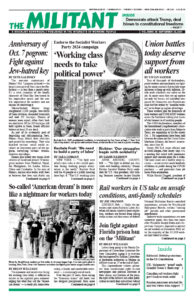LINCOLN, Neb. — Under the notorious anti-union Railway Labor Act, when rail union contracts near expiration, workers are barred from taking strike action and face years of federal National Mediation Board-controlled negotiations, reviews by Presidential Emergency Boards, various “cooling off” periods and other government interference.
Industry-wide negotiations are now underway again, less than two years after President Joseph Biden and a bipartisan Congress imposed a contract on rail workers in December 2022, after the majority of the 115,000 workers had voted to strike.
The railroad freight industry press reports that three of the six Class 1 railroads — BNSF, CSX, and Norfolk Southern — have reached tentative agreements with as many as nine of the unions that organize their workers. The tentative agreements come four months before collective bargaining can begin under the Railway Labor Act.
The unions announcing tentative agreements include three of the largest on the railroads — SMART-TD conductors and yardmasters, members of the Brotherhood of Maintenance of Way track workers and the Brotherhood of Railway Carmen/TCU. These deals have yet to be voted on by the memberships.
One significant difference between these negotiations and those from 2019-22 is that then all the rail unions agreed to negotiate collectively. They organized public rallies and marches to get broader support, and all 12 pledged that if any one union goes on strike, they all go out.
Today, each union is bargaining separately. Notably without any agreements reached so far is the Brotherhood of Locomotive Engineers and Trainmen, with about 23,000 working locomotive engineers and some conductors. Some BLET leaders have criticized the tentative contract agreements, saying they will not serve as a so-called pattern for what they will accept.
The tentative pact agreed to by the officials of the Brotherhood of Railway Carmen and Transportation Communications International Union contains a 17.5% wage increase over a five-year agreement (3.5% per year), along with some improvements in vacations and health insurance.
But they don’t guarantee more humane work schedules with time off for workers to spend with their families — one of the most important questions facing all rail workers — or cost-of-living escalator clauses to relieve the corrosive effects of rising prices, or agreements for much needed increased training time for new hires, much less hiring more workers to run and inspect the trains and the tracks.
These were some of the reasons rail workers rejected the 2022 contract and set a strike deadline in which all 12 rail unions had pledged to participate.
Need for a change
Rail workers face increasingly dangerous working conditions today. Union Pacific conductor Austin Scott Raysby, 34, was struck and killed by a Metra/UP train in Kenosha, Wisconsin, Sept. 4. In July another Union Pacific conductor was killed near Chicago after completing his short training program.
“Working conditions on the railroads today make for an unforgiving life,” Lance Anton, a Lincoln conductor and SMART-TD union member with some 12 years’ experience, told the Militant. “Rail workers have to deal with working 12-hour shifts or longer, at times in difficult weather, and dealing with continuous harassment and speedup.”
A look at how the rail bosses have slashed the workforce points to the depth of the problem. In 1973 there were 587,000 rail workers, 83% of whom were in unions. Today there are only 199,000 rail workers, with only 54% in unions. Over the past decade, profits for the rail bosses have risen while the real value of workers’ wages fell 30%.
“Rail bosses need to be forced by the unions to provide more training before new hires are set up to be conductors,” Anton said. “It takes two to three years’ experience for conductors and engineers to work safely and with confidence, to learn the company rules, the yard and road terrains, to spot cars at industry sidings, where other crews are working and many derailments happen.”
The Union Pacific and BNSF bosses reported to the Federal Railroad Administration that they had a total of 1,936 “human factor-caused accidents from 2020 to 2024.” That figure — likely a substantial undercount — reflects the result of the bosses’ drive for profits.
No rail worker needs to die on the job!
“The life-and-death issue of safety is not a bargainable question,” Rachele Fruit, who has talked to rail workers across the country as Socialist Workers Party candidate for U.S. president, told the Militant.
“Workers’ determination to fight is on the rise today. Rail workers see the resistance being mounted by truckers, autoworkers, nurses and many others. They set an example of how all workers are part of a great class, the working class, with the power to use their unions to fight for workers control over their work conditions.”
The fact is laws like the Railway Labor Act are just a piece of paper. It is the class struggle and relationship of class forces that decides if anti-union government moves can be enforced.
Rail workers need a crew of four on every train, two on the locomotive and two in the rear, and trains no longer than 50 cars.
Naomi Craine, a SMART-TD conductor, contributed to this article.


